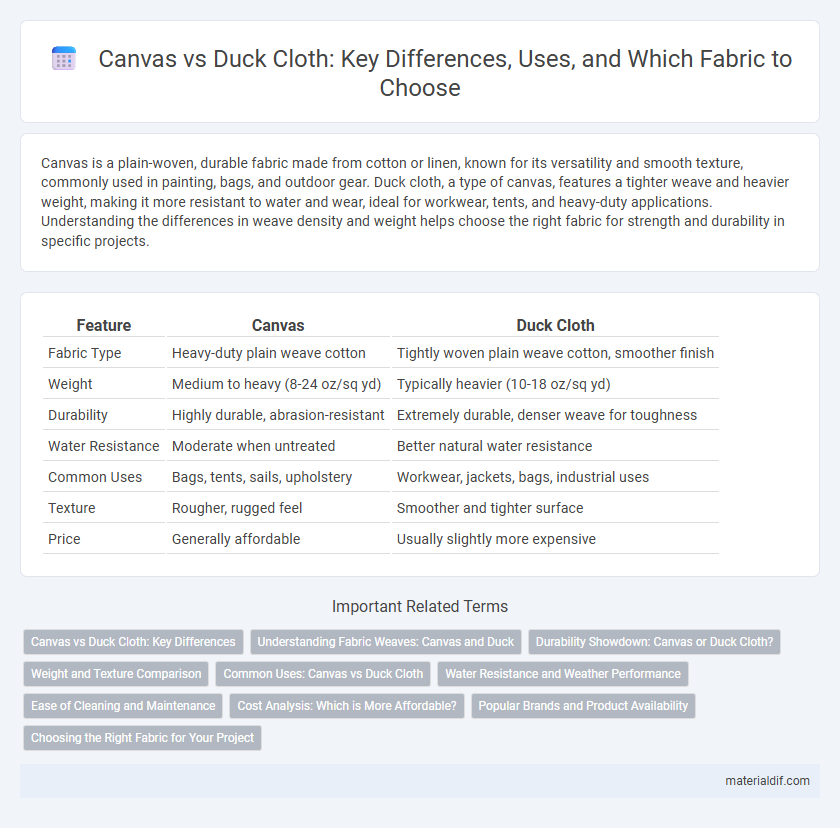Canvas is a plain-woven, durable fabric made from cotton or linen, known for its versatility and smooth texture, commonly used in painting, bags, and outdoor gear. Duck cloth, a type of canvas, features a tighter weave and heavier weight, making it more resistant to water and wear, ideal for workwear, tents, and heavy-duty applications. Understanding the differences in weave density and weight helps choose the right fabric for strength and durability in specific projects.
Table of Comparison
| Feature | Canvas | Duck Cloth |
|---|---|---|
| Fabric Type | Heavy-duty plain weave cotton | Tightly woven plain weave cotton, smoother finish |
| Weight | Medium to heavy (8-24 oz/sq yd) | Typically heavier (10-18 oz/sq yd) |
| Durability | Highly durable, abrasion-resistant | Extremely durable, denser weave for toughness |
| Water Resistance | Moderate when untreated | Better natural water resistance |
| Common Uses | Bags, tents, sails, upholstery | Workwear, jackets, bags, industrial uses |
| Texture | Rougher, rugged feel | Smoother and tighter surface |
| Price | Generally affordable | Usually slightly more expensive |
Canvas vs Duck Cloth: Key Differences
Canvas is a heavy-duty, plain-woven fabric characterized by its thick, durable texture made from cotton or linen, commonly used for painting and outdoor gear. Duck cloth, a specific type of canvas, features a tighter weave and smoother finish, providing enhanced water resistance and durability ideal for workwear and upholstery. The key differences lie in weave density, texture, and typical applications, with duck cloth offering a more refined and robust option within the canvas fabric category.
Understanding Fabric Weaves: Canvas and Duck
Canvas features a plain weave characterized by a simple, over-under interlacing of warp and weft threads, providing a sturdy and durable surface ideal for heavy-duty applications. Duck cloth, a type of canvas, employs a tighter, basket-like weave that enhances its strength and resistance to wear and tear, making it suitable for workwear, sails, and outdoor gear. Both fabrics use cotton or cotton-polyester blends, but duck cloth's denser weave results in higher abrasion resistance and water repellency compared to standard canvas.
Durability Showdown: Canvas or Duck Cloth?
Canvas and duck cloth are both heavy-duty fabrics known for their exceptional durability, but duck cloth generally offers a tighter weave, making it more resistant to wear and tear. Canvas, often made from cotton or linen, is slightly looser in weave, which provides breathability but can reduce its abrasion resistance compared to duck cloth. When comparing longevity for applications requiring tough, rugged material, duck cloth is typically the superior choice for enduring harsh conditions and heavy usage.
Weight and Texture Comparison
Canvas fabric generally weighs between 7 to 12 ounces per square yard, offering a coarser texture with a distinct weave that provides durability and breathability. Duck cloth is typically heavier, ranging from 10 to 18 ounces per square yard, featuring a tighter, smoother weave that enhances water resistance and abrasion strength. The weight difference affects the fabric's stiffness and durability, making duck cloth more suitable for heavy-duty applications compared to the more flexible, breathable canvas.
Common Uses: Canvas vs Duck Cloth
Canvas is commonly used for painting surfaces, tents, backpacks, and sails due to its heavy-duty and durable texture. Duck cloth finds frequent application in workwear, upholstery, and heavy-duty bags because of its tightly woven plain weave that offers excellent strength and resistance. Both fabrics are favored in scenarios requiring robust material, but duck cloth's tighter weave provides better protection against abrasion and moisture.
Water Resistance and Weather Performance
Canvas offers moderate water resistance, making it suitable for light outdoor use, while duck cloth provides superior water repellency due to its tighter weave and denser construction. Duck cloth's enhanced weather performance ensures better durability against rain and wind, maintaining structural integrity and dryness longer than traditional canvas. For applications demanding high water resistance and robust weather protection, duck cloth is the preferred fabric choice.
Ease of Cleaning and Maintenance
Canvas fabric typically offers easier cleaning and maintenance due to its smoother weave, allowing dirt and stains to be wiped off more effortlessly. Duck cloth, characterized by its heavier, tighter weave, is more durable but can trap dirt within its fibers, requiring more intensive cleaning methods such as deep washing or spot treatment. Both fabrics benefit from regular brushing and prompt stain removal, but canvas generally demands less rigorous upkeep for everyday use.
Cost Analysis: Which is More Affordable?
Canvas generally offers a more affordable option compared to duck cloth, as it is often produced with a lighter weave and fewer treatments, reducing manufacturing costs. Duck cloth, made with a tighter weave and heavier weight, tends to be more expensive due to its durability and specialized finishing processes. For budget-conscious projects requiring medium durability, canvas provides a cost-effective solution, while duck cloth justifies its higher price for heavy-duty applications.
Popular Brands and Product Availability
Canvas and duck cloth are widely available from popular fabric brands like Robert Kaufman, Joann Fabrics, and Mood Fabrics, known for offering high-quality textiles suitable for upholstery and crafting. Duck cloth tends to be heavier and more tightly woven than canvas, often preferred for durable workwear and outdoor gear, while canvas is favored for art, bags, and footwear due to its versatility. Major retailers and specialized fabric stores stock these fabrics in various weights and colors, ensuring easy access for hobbyists and professionals alike.
Choosing the Right Fabric for Your Project
Canvas offers a tightly woven, durable texture ideal for heavy-duty projects like bags and upholstery, while duck cloth features a softer, lighter weave suitable for lighter garments and casual wear. Understanding the weight and weave density helps determine which fabric matches your project's strength and flexibility requirements. Selecting the right material enhances longevity and performance, ensuring fabric suitability for specific applications.
canvas vs duck cloth Infographic

 materialdif.com
materialdif.com